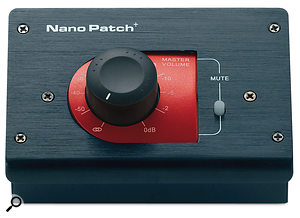I recently spent €4000 on professionally designed and installed acoustic design and treatment. I then spent a further €4000 on a pair of Adam S3X-V Monitors. As you can see, I care about sound! I will probably also buy a TC Electronic Konnekt 48 converter. However, for correct monitoring I need to change constantly the volume of what I'm hearing, and also switch between my main monitors and an Auratone 'HorrorCube'. For this reason I was obviously thinking of buying a monitor controller. The one I have in mind is the SM Pro Audio M-Patch 2. My first question is: will this colour the sound? Obviously, I don't want any unit between my converters and my bloody expensive monitors changing the sound in any way! If this model is no good I can always buy a Mackie Big Knob, but this costs about twice that of the SM Pro Audio model and simply has 20 more connections than I need. Also, if the SM Pro Audio controller changed the sound, wouldn't the Big Knob change it as well? As you can see, I'm not very confident about putting an additional unit between converters and monitors, but this is because I have never done it. Perhaps someone with more experience than me can help.Miguel Tain Rubio, via email
SOS Reviews Editor Matt Houghton replies: First of all, it should be pointed out that an optional remote control is available for the Konnekt 48, providing volume control and the ability to switch between up to three sets of speakers, among other functions. This might well prove to be a simple, convenient and good-sounding solution for your purposes. If there's a possible down side, it's that in common with adjusting levels in software, it presumably attenuates the signal in the digital domain, which theoretically might not give the best results; it also means you have no 'hard' control over the levels reaching your speaker, so if for some reason the interface crashes and puts out full-scale noise, you risk ear and speaker damage. For that reason a separate monitor controller might still be worth investigating.
It's true that affordable active monitor controllers can 'colour' the sound slightly, though I haven't personally used the Mackie Big Knob. The M-Patch 2, however, is a passive device, so should be transparent. We reviewed it back in Sound On Sound December '06, if you want to know more about it (/sos/dec06/articles/smprompatch.htm). If I were to choose an active controller, I'd probably go for a more expensive device with high-quality onboard D-A converters, such as the DACS Headmaster (/sos/nov09/articles/dacsheadmaster.htm), Crookwood C2 (/sos/aug07/articles/crookwoodc2.htm) or Dangerous D-Box (/sos/mar09/articles/dangerousdbox.htm), amongst others. This isn't a cheap option, but you'll generally get a lot more functionality and high-quality converters that don't tie up the analogue I/O on your audio interface.
Before you convince yourself of the need to splash the cash, though, I'd suggest pausing for thought: people have been making great records using the active monitor control functions on mixing consoles of varying quality for decades. In other words, it's possible to get very hung up on making everything in the signal chain technically perfect and forgetting about the business of making music!
SOS Technical Editor Hugh Robjohns adds: In my experience, budget active monitor controllers often do colour the sound slightly, and truly 'transparent' active controllers are inherently expensive beasts, and they often incorporate facilities that are simply not required in some installations.
For that reason, a well thought-out passive monitor controller is often a better solution and, provided the switches and attenuators are of good quality, they should be extremely transparent — certainly more so than an equivalently priced active controller.
Our own Martin Walker uses the M-Patch 2, and I use the same company's NanoPatch quite a lot. Other models to consider are the Presonus Central Station (although I think the remote control option can sometimes colour the sound a little), or the Coleman MPH3. This last model is quite expensive, but has the advantage of a proper switch-stepped attenuator, which guarantees inter-channel accuracy and the ability to set precise and repeatable listening levels. It is my preferred option, given a choice (and the budget)!  Truly transparent active controllers are inherently expensive things to buy, so a passive monitor controller could be a better-value option to consider if you are concerned about colouring the sound. The SM Pro NanoPatch+ is a simple volume control, while the Presonus Central Station offers speaker and input switching too.
Truly transparent active controllers are inherently expensive things to buy, so a passive monitor controller could be a better-value option to consider if you are concerned about colouring the sound. The SM Pro NanoPatch+ is a simple volume control, while the Presonus Central Station offers speaker and input switching too.
There are a couple of things to be aware of when using passive controllers, however. Their very nature makes them sensitive to the output and input impedances of the source and destination equipment (respectively), which can affect signal levels slightly, and potentially also result in subtle low-pass filtering in extreme cases. Thankfully, this is rarely a problem in practice, though. It's also best to keep connecting cables as short as possible too.
